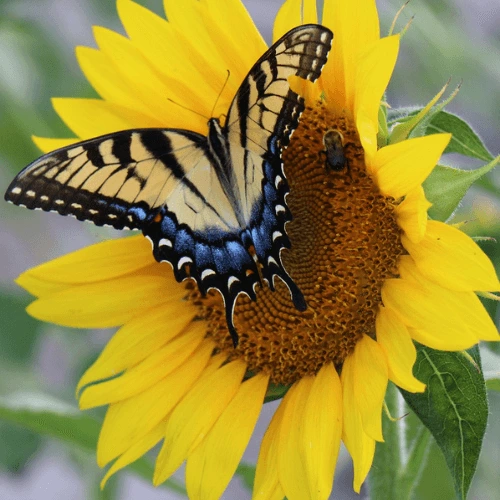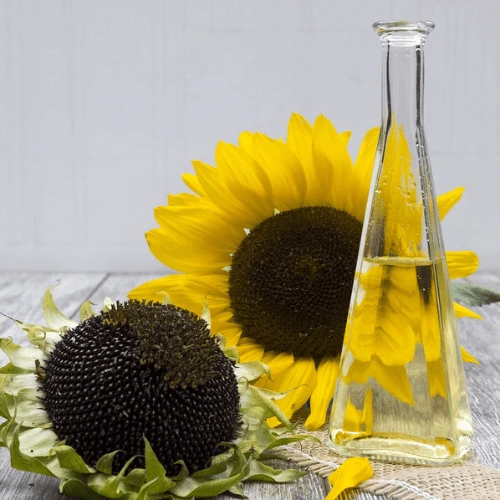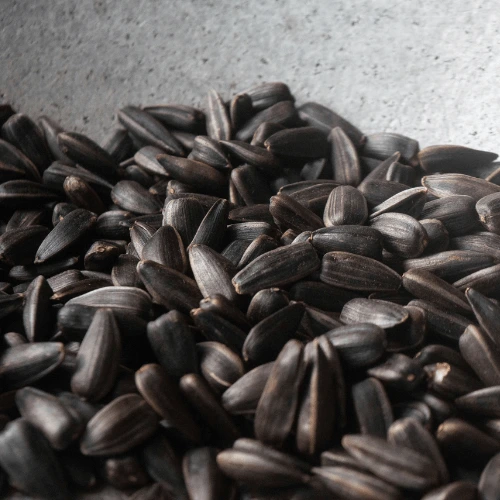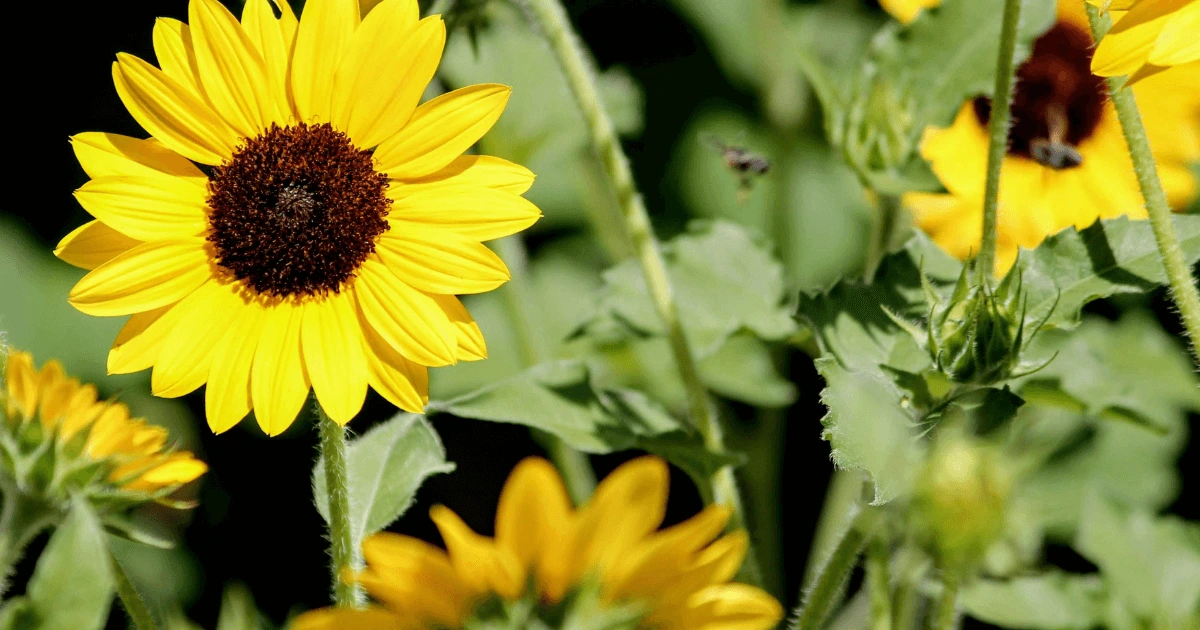Have you ever noticed the striking allure of black sunflowers in a garden or wondered why black oil sunflower seeds are a favorite among wildlife enthusiasts? These unique blooms and their nutrient-packed seeds offer so much more than just visual appeal. From attracting birds and bees to providing practical benefits for gardeners, black sunflowers are a versatile choice for anyone looking to enhance their outdoor space.
Whether you’re a seasoned gardener or just starting out, this blog will guide you through everything you need to know about growing, harvesting, and using black sunflowers and their seeds. Get ready to discover how these beautiful plants can transform your garden while supporting the local ecosystem. Let’s dive in!
In This Article
Understanding Black Sunflowers and Black Oil Sunflower Seeds
Have you ever wondered what makes black sunflowers stand out in a garden? These stunning blooms aren’t just a visual treat; they also play a vital role in attracting wildlife and supporting eco-friendly gardening. But what about the seeds? Let’s dive into what makes black oil sunflower seeds so special.



What Are Black Sunflowers?
Black sunflowers are known for their deep, dramatic hues and their ability to thrive in various conditions. They’re a favorite among gardeners for their bold appearance, adding a touch of elegance to any landscape. Plus, their nectar-rich flowers attract pollinators like bees and butterflies, making them an excellent choice for sustainable gardening.
Why Choose Black Oil Sunflower Seeds?
If you’re into birdwatching or simply love supporting local wildlife, black oil sunflower seeds are a must-have. These seeds are packed with nutrients and have a thin shell, making them easy for birds like cardinals, chickadees, and finches to enjoy. They’re also highly versatile:

- For Wildlife Feeding: These seeds are a top pick for bird feeders, providing essential energy during colder months.
- For Gardening Benefits: Leftover seeds can enrich the soil, promoting healthier plants in your garden.
Whether you’re an experienced gardener or a beginner, black sunflowers and their seeds offer a blend of beauty and practicality that’s hard to resist. Excited to bring these striking blooms to your garden?Let’s explore more!
Benefits of Growing Black Sunflowers
Why should black sunflowers have a spot in your garden? Beyond their striking beauty, these blooms bring a host of benefits that make them a favorite among gardeners and nature lovers alike. Let’s uncover how black sunflowers can enhance your outdoor space.
1. Elevate Your Garden’s Aesthetic Appeal
Black sunflowers, like the popular Black Beauty Sunflower, add a unique touch of sophistication to your garden. Their deep, rich hues stand out against vibrant greenery, creating a stunning focal point. Whether planted in rows or mixed with other blooms, they’re sure to catch the eye of anyone who passes by.
Pro tip: Pair black sunflowers with lighter-colored flowers for a dramatic contrast that turns your garden into a work of art.
2. Support Local Wildlife
Did you know that growing black sunflowers can help sustain your local ecosystem? Here’s how:
- Attract Pollinators: Bees, butterflies, and other beneficial insects are drawn to the nectar-rich blooms, aiding in pollination for your garden plants.
- Feed Birds and Small Animals: Once the seeds mature, they become a favorite snack for birds like finches and cardinals, as well as squirrels and other wildlife.
By planting black sunflowers, you’re not just beautifying your space—you’re creating a sanctuary for local fauna.
3. Easy to Grow and Maintain
Even if you’re new to gardening, black sunflowers are a fantastic choice. These hardy plants adapt to various soil types and climates, making them an accessible option for gardeners across the USA.
A few quick tips for success:
- Plant them in a sunny spot with well-draining soil.
- Ensure they receive regular watering, particularly during dry periods, while being careful not to overwater.
- Apply organic mulch to help conserve moisture and keep weeds under control.
Their resilience means you can enjoy all their benefits without spending hours on upkeep.
Why Black Sunflowers Are Worth It
Whether you’re drawn to their bold appearance, their ability to support wildlife, or their low-maintenance nature, black sunflowers offer something for everyone. They’re a perfect blend of beauty and utility, turning any garden into a lively, eco-friendly haven.
So, why wait? Start planning your black sunflower garden today and enjoy the countless rewards these stunning flowers bring.
How to Grow Black Sunflowers Successfully
Thinking about growing black sunflowers in your garden? Whether you’re an experienced gardener or a beginner, you’ll be glad to know these striking blooms are surprisingly easy to cultivate. Let’s break down the steps so you can get started with confidence.
1. Choosing the Right Seeds
Not all sunflower seeds are created equal. For black sunflowers, consider the Peredovik Sunflower, a popular variety known for its robust growth and high oil content. Ensure you purchase seeds from a reputable supplier to guarantee quality and viability.
When selecting seeds, keep these tips in mind:
- Look for seeds labeled specifically for gardening or wildlife feeding.
- Avoid chemically treated seeds if you aim for an eco-friendly garden.
2. Preparing Your Soil
Black sunflowers thrive in well-draining, nutrient-rich soil. Before planting:
- Aerate the soil to promote deep root growth.
- Incorporate compost or organic fertilizer to enrich the soil with essential nutrients.
Sunflowers prefer slightly acidic to neutral pH levels (6.0–7.5). You can test your soil with an inexpensive kit from a garden store to make adjustments if needed.
3. Planting Your Black Sunflowers
Timing is key! Plant sunflower seeds after the last frost, when the soil temperature reaches at least 50°F. Follow these steps:
- Dig a hole about 1–2 inches deep for each seed.
- Space seeds 6–12 inches apart for smaller blooms or 18–24 inches apart for larger varieties.
- Cover with soil and water gently.
Black sunflowers love the sun, so pick a spot that gets at least 6–8 hours of direct sunlight daily.
4. Caring for Your Plants
Once your sunflowers start sprouting, here’s how to keep them thriving:
- Watering: Water deeply but infrequently, aiming for 1–2 inches of water per week.
- Fertilizing: Apply periodically a balanced fertilizer to support robust growth.
- Pest Management: Watch out for pests like aphids or birds. Consider organic solutions like neem oil or netting to protect your plants.
5. Patience Pays Off
Within 70–90 days, you’ll see your sunflowers reach their full glory. Their tall stalks and dark blooms are well worth the wait, adding beauty and life to your garden.
By following these steps, you’ll create the perfect environment for black sunflowers to flourish. Ready to give it a try? Get your seeds, prep your soil, and let nature do the rest!
Harvesting Black Oil Sunflower Seeds
Growing black sunflowers is rewarding, but harvesting their seeds is where the real excitement begins! If you’ve been wondering when and how to collect those nutrient-rich black oil sunflower seeds, here’s everything you need to know to make the most of your harvest.
When Are Black Oil Sunflower Seeds Ready to Harvest?
Timing is everything. It is time to harvest when you notice:
- The flower heads droop, and the back turns from green to a yellowish-brown.
- Seeds appear plump and have a dark, black coating.
- Petals have fallen off, and the seeds are tightly packed in the head.
It’s essential to act quickly, as birds and squirrels love these seeds just as much as you do!
How to Harvest Black Oil Sunflower Seeds
Harvesting sunflower seeds is straightforward and satisfying. Here’s a step-by-step guide:
- Cut the Heads: Use sharp garden shears to cut the flower head, leaving about 12–18 inches of the stalk attached for easier handling.
- Dry the Heads: Hang the flower heads upside down in a cool, dry place with good airflow. You can tie a paper bag around each head to catch falling seeds and deter pests.
- Extract the Seeds: Once the heads are fully dry (this usually takes 1–2 weeks), rub the seeds loose with your hands or a stiff brush.
Storing Your Harvest
To keep your seeds fresh and usable, proper storage is key:
- Keep the seeds in an airtight sealed container to protect them from moisture.
- Keep them in a cool, dark place, such as a pantry or refrigerator.
- Label your container with the date of harvest to track freshness.
Properly stored black oil sunflower seeds can last up to a year, making them a fantastic resource for feeding wildlife or planting the following season.
Pro Tips for a Successful Harvest
- If you’re harvesting for bird feeders, leave a few flower heads in the garden for birds to enjoy directly.
- For human consumption (after confirming they’re untreated), lightly roast seeds with a sprinkle of salt for a tasty snack.
By following these steps, you’ll not only enjoy the beauty of black sunflowers but also reap the benefits of their nutrient-packed seeds. So, are you ready to gather your harvest? It’s a fun and rewarding process that connects you even closer to nature.
Uses for Black Oil Sunflower Seeds
Have you ever wondered how versatile black oil sunflower seeds can be? These tiny powerhouses are packed with potential, offering benefits for wildlife, gardening, and even DIY projects. Let’s explore the many ways you can make the most of them.
1. Feeding Wildlife
If you love attracting birds and wildlife to your yard, black oil sunflower seeds are a game-changer. Here’s why they’re a favorite:
- Bird Feeders: Their thin shells and high oil content make them easy for birds like cardinals, finches, and chickadees to enjoy. Add them to your feeder, and you’ll quickly notice an increase in feathered visitors.
- Natural Feeding Stations: Leave a few sunflower heads in your garden during the fall. Birds and small animals will flock to them, creating a natural and dynamic feeding environment.
2. Enhancing Your Garden
Black oil sunflower seeds aren’t just for wildlife—they can benefit your garden too!
- Composting: Crushed or leftover seeds can enrich your compost pile, adding organic material that helps soil retain moisture and nutrients.
- Companion Planting: Sunflower plants can serve as a natural trellis for climbing plants like beans, offering shade and support.
3. Creative DIY Projects
Feeling crafty? Black oil sunflower seeds can be used in fun and practical projects:
- Homemade Bird Suet: Combine seeds with lard or peanut butter to create suet cakes for winter feeding.
- Seed Art: Use seeds to craft mosaics or decorations for your home or garden.
Why Choose Black Oil Sunflower Seeds?
Their versatility and affordability make them a go-to choice for gardeners and wildlife enthusiasts alike. Whether you’re nurturing your backyard ecosystem or exploring creative uses, these seeds truly shine.
So, what will you do with your black oil sunflower seeds? The possibilities are endless, and the rewards—both for you and your environment—are worth every effort!
Growing Sunflowers in Containers
Container gardening is an excellent way to enjoy the beauty of sunflowers, even if you’re short on space. Whether you have a small balcony, patio, or simply love the idea of mobile blooms, growing sunflowers in pots is both rewarding and surprisingly simple. Here’s everything you need to know to get started:
1. Choosing the Right Container: Size Matters!
Not all containers are created equal, especially for sunflowers. These plants love to stretch their roots, so aim for:
- Depth: Choose a container at least 12–16 inches deep to give roots ample space.
- Width: A pot 12 inches wide or more works best for single large sunflowers or a cluster of smaller ones.
Ensure the container has proper drainage holes to prevent soggy roots—a common enemy of happy plants. Terracotta pots are great for sunflowers because they allow excess moisture to evaporate.
2. Selecting the Best Sunflower Varieties for Containers
Not all sunflowers thrive in pots, so picking the right variety is key. Some excellent options include:
- Black Beauty Sunflower: Compact and elegant, perfect for containers.
- Peredovik Sunflower: A smaller variety known for its stunning blooms and vibrant seeds.
- Dwarf Sunflowers: Varieties like ‘Teddy Bear’ or ‘Pacino Gold’ offer bright blooms in a manageable size.
When browsing seeds, look for terms like “dwarf,” “compact,” or “container-friendly.”
3. Planting Guide: Step-by-Step to Sunflower Success
Here’s how to get those seeds sprouting in no time:
- Prepare the Soil:
- Opt for a premium potting mix enhanced with organic matter.
- Add a slow-release fertilizer to give your sunflowers a nutrient boost.
- Planting Seeds:
- Sow seeds directly into the container about 1 inch deep and spaced 4–6 inches apart.
- Cover lightly with soil and water gently.
- Position for Success:
- Position your container in a location that receives a minimum of 6–8 hours of direct sunlight each day.
- Sunflowers are sun lovers—give them the brightest spot possible.
4. Caring for Container Sunflowers
Once your sunflowers start growing, a little TLC goes a long way:
- Watering:
- Keep the soil moist but not waterlogged.
- Fertilizing:Feed your sunflowers with a balanced liquid fertilizer every 2–3 weeks to support their growth.
- Staking (Optional):
- Tall varieties might need some support. Use a bamboo stake to prevent the stalks from bending or breaking.
5. Troubleshooting: Common Issues with Container Sunflowers
Worried about pests or diseases? Don’t be! Here’s how to tackle common problems:
- Yellowing Leaves?
Likely overwatering—let the soil dry out a bit before the next watering. - Aphids or Mites?
Spray the leaves with a gentle mix of water and mild dish soap to keep pests at bay. - Leggy Growth?
If your sunflower looks stretched, it’s craving more sunlight—relocate to a sunnier spot.
6. The Joy of Portable Sunflowers
One of the best parts about growing sunflowers in containers is their portability. If a storm is coming or you want to redesign your outdoor space, simply move your sunflower to safety or to its new spot. This flexibility makes container sunflowers a practical choice for gardeners of all levels.
Growing sunflowers in containers is a delightful way to bring sunshine to any space. With a little planning and care, you’ll enjoy vibrant blooms that brighten your days and perhaps even inspire a few smiles from passersby. Ready to give it a try? Grab some seeds, and let’s grow!
Common Questions About Black Sunflowers and Seeds
Curious about black sunflowers and their versatile seeds? You’re not alone! Many gardeners and wildlife enthusiasts have questions about how to make the most of these unique blooms. Let’s tackle some of the most common queries to help you get started.
1. Are Black Oil Sunflower Seeds Edible for Humans?
Yes, but with a caveat. Black oil sunflower seeds are primarily grown for wildlife feed due to their thin shells and high oil content. While they’re safe for humans, their taste and texture might not be as appealing as striped sunflower seeds typically sold for snacking.
If you’re feeling adventurous:
- Use them for homemade sunflower oil by pressing the seeds.
- Try roasting them lightly with a bit of salt for a unique snack.
2. Do Black Sunflowers Require Special Care?
Not at all! Black sunflowers are hardy and low-maintenance, making them perfect for beginners. Just follow these simple tips:
- Sunlight: Ensure they’re planted in a sunny spot—6–8 hours of direct sunlight daily is ideal.
- Watering: While drought-tolerant, they’ll thrive with consistent watering, especially during dry spells.
- Pests: Be extremely vigilant for typical pests like aphids. Consider applying natural pest control techniques when required.
3. What’s the Difference Between Black Sunflowers and Black Beauty Sunflowers?
The Black Beauty Sunflower is a specific variety known for its ornamental appeal and rich, velvety petals. It’s often grown for its aesthetic value, while general black sunflowers may focus more on seed production for wildlife and oil.
4. Can Black Oil Sunflower Seeds Be Planted for New Sunflowers?
Absolutely! Just make sure the seeds are untreated (not processed for bird feed or culinary use). Simply plant them in well-draining soil during the spring, and you’ll enjoy beautiful blooms in a few months.
What’s Next for Your Black Sunflower Journey?
Black sunflowers and their seeds offer endless possibilities, whether you’re feeding wildlife, beautifying your garden, or diving into DIY projects. With a little care and creativity, they can become one of the most rewarding additions to your gardening repertoire.
Still have questions? Feel free to ask—there’s always more to learn about these fascinating plants!
Conclusion
Black sunflowers and black oil sunflower seeds bring more than beauty to your garden—they create a thriving space for wildlife, enrich your soil, and offer countless uses. Whether you’re planting these stunning blooms for their bold aesthetic or harvesting seeds to feed birds and enhance your garden, the rewards are truly unmatched.
So, are you ready to make black sunflowers a part of your gardening journey? With their versatility and low-maintenance nature, they’re an ideal addition to any outdoor space. Grab your seeds, roll up your sleeves, and start planting—you’ll soon see why these sunflowers are loved by gardeners and nature enthusiasts alike.
What will you do first: grow these striking blooms, harvest their seeds, or both? Whatever you choose, you’re sure to enjoy the beauty and benefits they bring. Happy gardening!

